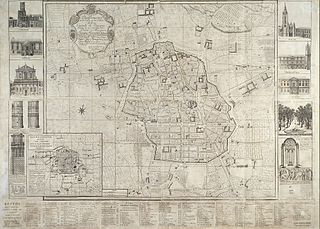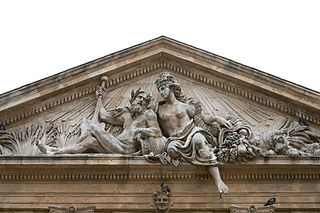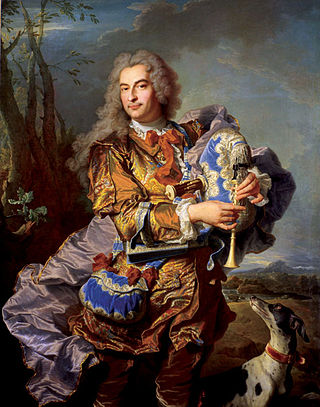
Joseph-Marius Ramus (1805-1888) was a French sculptor. [1] [2] [3] [4]

Joseph-Marius Ramus (1805-1888) was a French sculptor. [1] [2] [3] [4]
He was born on June 19, 1805, in Aix-en-Provence, Bouches-du-Rhône, France. [1] [2] [3] [5] He was taught by Jean-Pierre Cortot (1787–1843). [1] [2]
According to Ambroise Roux-Alphéran, Louis Nicolas Philippe Auguste de Forbin once said that in the same way as Marseille had Pierre Paul Puget, Ramus could become Aix's best sculptor. [5]
Some of his sculptures can be found in the Musée Granet in Aix-en-Provence. [6] Moreover, the Palace of Justice of Aix-en-Provence is flanked by two of his sculptures. More of his sculptures can be found in Digne (Statue de Gassendi), Marseille (Statue de Pierre Puget in Parc Borély) and Paris (Buste de Tourville in Musée national de la Marine). [4]
He died in 1888 in Nogent-sur-Seine. [3]
The Place Ramus in Aix-en-Provence is named in his honor. [7]

Aix-en-Provence, or simply Aix, is a city and commune in southern France, about 30 km (20 mi) north of Marseille. A former capital of Provence, it is the subprefecture of the arrondissement of Aix-en-Provence, in the department of Bouches-du-Rhône, in the region of Provence-Alpes-Côte d'Azur. The population of Aix-en-Provence is approximately 145,000. Its inhabitants are called Aixois or, less commonly, Aquisextains.

Aix Cathedral in Aix-en-Provence in southern France is a Roman Catholic church and the seat of the Archbishop of Aix-en-Provence and Arles. The cathedral is built on the site of the 1st-century Roman forum of Aix. Built and re-built from the 12th until the 19th century, it includes Romanesque, Gothic and Neo-Gothic elements, as well as Roman columns and parts of the baptistery from a 6th-century Christian church. It is a national monument of France.

Ambroise Roux-Alphéran (1776–1858) was a French public official and historian.

Jean Joseph Marius Diouloufet was a Provençal poet.

Porte d'Aix is a triumphal arch in Marseille, in the south of France, marking the old entry point to the city on the road from Aix-en-Provence. The classical design by Michel-Robert Penchaud was inspired by the triumphal arches of the Roman Empire. The Porte d’Aix was initially conceived in 1784 to honour Louis XVI and to commemorate the Peace of Paris (1783) that ended the American Revolutionary War. Following the restoration of the Bourbon monarchy in 1814–15, the project was resumed in 1823, now to commemorate French victories in the Spanish Expedition, notably at the Battle of Trocadero, August 31, 1823. It was eventually completed in 1839, with a more general theme of victory.

Louis Nicolas Victor de Félix d'Ollières, comte du Muy, comte de Grignan, was a French soldier and statesman from a family originating in Provence. He was made a member of the Ordre du Saint-Esprit in 1764.

The quartier Mazarin is a district in the centre of Aix-en-Provence, directly to the south of the cours Mirabeau, the principal boulevard in Aix. On the initiative of Archbishop Michel Mazarin, brother of the Cardinal Jules Mazarin and Archbishop of Aix from 1645-8 and later himself a cardinal, city plans were devised in 1646 by Jean Lombard, director of public works, to extend the city ramparts to the south, incorporating land owned by the Archbishopric of Aix and by the Order of Saint-Jean-de-Malte. Following a grid plan of streets, the quartier contains a large number of hôtels particuliers originally built for the nobility and wealthy merchant class.

Jean-Pancrace Chastel (1726-1793) was a French sculptor.

Gaspard de Gueidan (de Valabre) (1688–1767) was a French aristocrat and lawyer. He served as the Président à mortier of the Parliament of Aix-en-Provence.

Jean-Pierre-François de Ripert-Monclar (1711–1773) was a French aristocrat, landowner and lawyer.

The Hôtel du Poët is a listed hôtel particulier in Aix-en-Provence.

Henri Gautier (1676–1757) was a French aristocrat, landowner and public official.
Honoré-Gaspard de Coriolis (1735–1824) was a French Roman Catholic cleric and historian.

The Hôtel de Gantès is a listed hôtel particulier in Aix-en-Provence. Built in 1660, it was home to a private members' club until the French Revolution of 1789, when two aristocratic members were murdered by revolutionaries. Since the 1840s, it has been home to the world-famous café, Les Deux Garçons, a haunt of artists, writers and celebrities.
François de Gantès (1596-1679) was a French aristocrat, landowner and military commander.
Charles Jean-Baptiste des Gallois de La Tour (1715–1802) was a French public official. He served as the last First President of the Parliament of Aix-en-Provence from 1748 to 1771, and from 1775 to 1790.

The Hôtel de Gueydan is a listed hôtel particulier in Aix-en-Provence, Bouches-du-Rhône, France.
Hippolyte Ferrat (1822–1882) was a French sculptor from Aix-en-Provence. He specialised in busts. He designed public sculptures in Provence as well as busts for private collections and city halls. His work can be found in museums in Europe and the United States.
Barthélémy-François Chardigny (1757-1813) was a French sculptor. He designed public sculptures in Marseille.
Honoré Bouche was a French priest and historian of Provence.